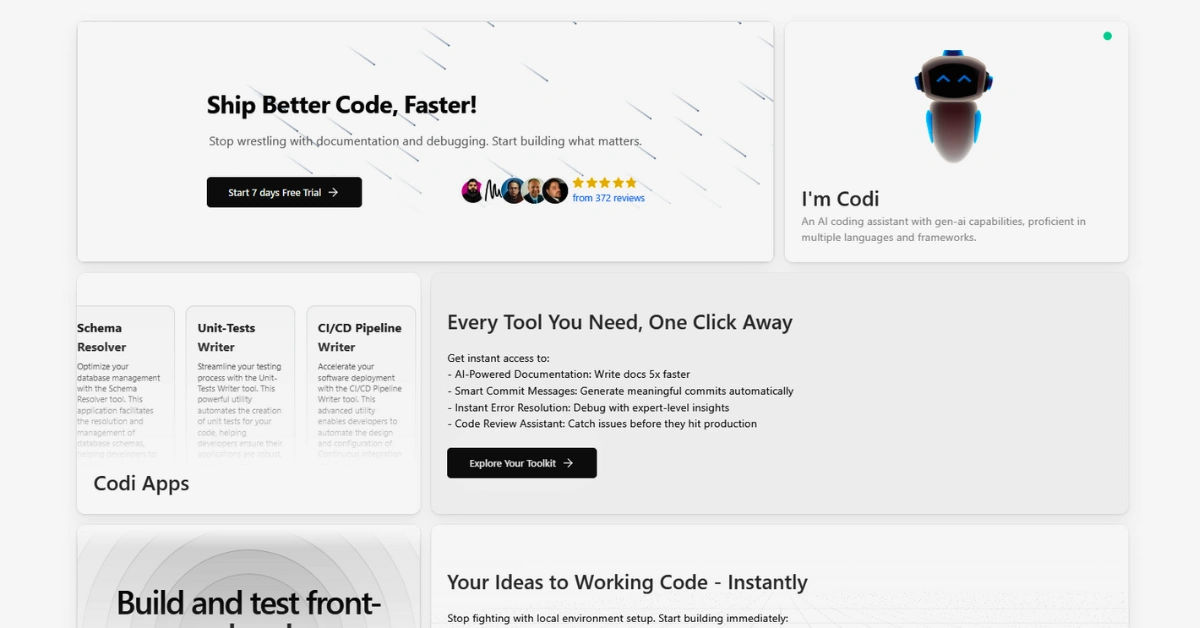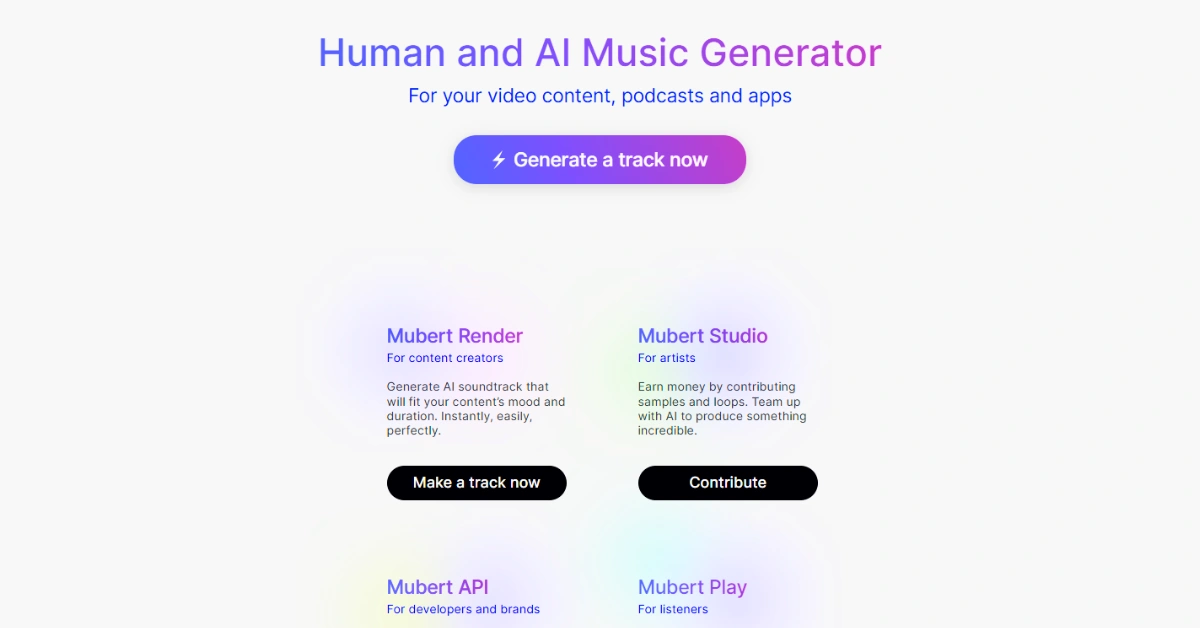A Complete Guide on Semi-Supervised Learning

We might have heard of two common machine learning types – supervised and unsupervised machine learning. These types help the most with the labelled and unlabeled data sets. But what happens when labelling data is expensive, time-consuming, or impractical?
This is where the third type comes in: semi-supervised learning that acts as a strong ground between supervised and unsupervised machine learning. From analyzing medical images with limited annotations to pointing out spam or fraud in financial transactions, semi-supervised learning is transforming how we innovate and train AI systems.
Don’t worry if you are still not aware of this type of machine learning! We’ve got you covered! In this article, we will explore what supervised machine learning is, how it works, key algorithms, benefits, real-world use cases, and much more! Let’s delve into this!
What is Semi-Supervised Learning?
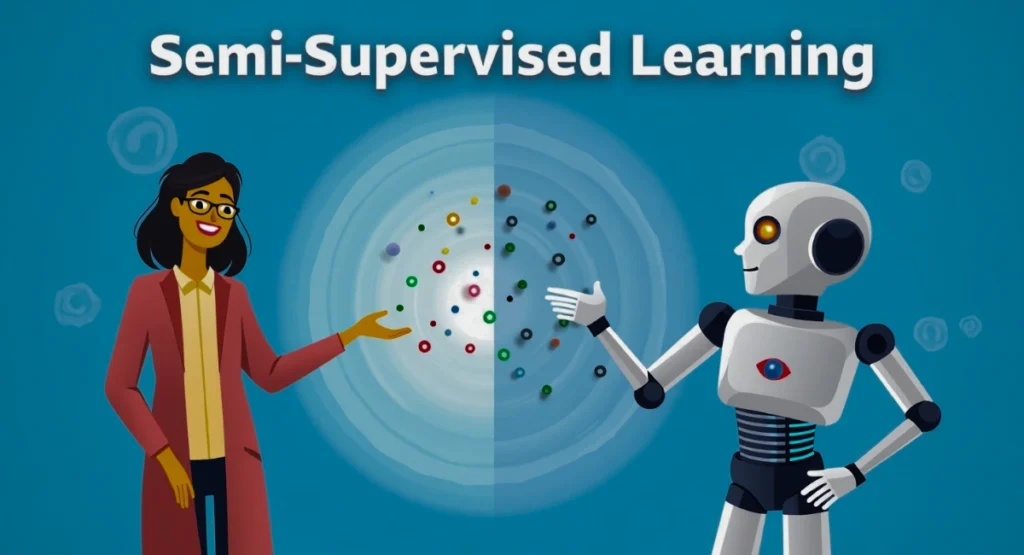
Semi-supervised learning is a machine learning approach that uses a small amount of labeled data and a vast amount of unlabeled data to train models. In simpler words, this approach bridges the gap between supervised learning (requires labeled data) and unsupervised learning methods (requires only unlabeled data). Moreover, this type is best for building cost-efficient and accurate models when labelling data is expensive or time-consuming.
Real World Analogy: Imagine you’re learning a new language. You attended a few classes (labelled data), but you mostly practice the language by watching movies and reading books in that language (unlabelled data). Over time, your understanding will improve by getting information from both resources, just like a model trained with semi-supervised learning.
Supervised vs. Unsupervised vs. Semi-Supervised Learning
Before we delve deep into semi-supervised learning and its use cases, it is crucial to understand the difference between the three types of machine learning. Let’s explore the key differences:
Feature | Supervised Learning | Unsupervised Learning | Semi-Supervised Learning |
Data Type | Works with fully labeled data | Completely unlabeled | Mixture of both data |
Goal | Predict outcomes or classify data | Explore hidden patterns or relations | Enhance learning accuracy with minimal labels |
Examples | Email spam detection | Customer Segmentation | Web content classification |
Labeling Cost | High | None | Moderate |
Common Algorithm Used | Logistic regression, decision trees | K-means, PCA | Self-training, pseudo-labelling |
How Semi-Supervised Learning Works?
Till now, you get that the semi-supervised learning process works by bridging the gap between supervised and unsupervised learning. This hybrid approach is particularly beneficial when dealing with the time-consuming, costly data labelling and shaping underlying data distribution from unlabeled data.
Labeled vs Unlabeled Data
Well, in usual cases, the data distribution consists of 5-10% labeled data and 90-95% unlabeled data. Talking about the model training, it initially learns patterns from the labeled dataset, then iteratively improves itself by using patterns in the unlabeled segment and performs the training task. The intention is to generalize better with less supervision by capturing the essence of the entire dataset.
Process Flow:
- Start with labeled data to develop an initial model.
- Use this model to anticipate labels for unlabeled data in the initial training process.
- Enter the most confident predictions into the labeled set.
- Re-train and optimize the model for better performance.
The Role of Model Assumptions in SSL
Generally, SSL techniques are beneficial only when some assumptions about the data distribution come true:
- Cluster Assumption: In this, data are classified into discrete clusters. It means few data points belonging to the same clusters are likely to share the same label. SSL uses this by placing similar data and propagating it within those clusters.
- Manifold Assumption: Commonly, high-dimensional data usually lies on a lower-dimensional manifold than the input space. SSL techniques utilize this by learning representations that respect the structure of the data geometry.
- Low-Density Assumption: It is based on that decision boundaries should remain in the low-density regions of the data space, limiting the chance of misclassification near data clusters.
- Smoothness Assumption: The assumption states that if two points in a high-density area are close, then their surrounding labels should be the same. It is also called a continuity assumption.
Transductive vs Inductive Learning
- Transductive Learning: It emphasizes predicting labels specifically for unlabelled data given during training. It does not generalize the unknown data.
- Inductive Learning: It is built on a general model that can be applied to give accurate predictions on unseen data (true data distribution), without the training set. It is most commonly used in real-world scenarios where adaptability is crucial.
Key Techniques in Semi-Supervised Learning

Here are some common techniques that are used in semi-supervised learning:
Self-training (Pseudo-labeling)
- This type of technique uses a partially trained model on the originally labeled data to forecast labels for unlabeled data.
- Additionally, confident predictions are used again and again as new labeled data in the next training phase.
- This semi-supervised learning approach (pseudo-labeled data) is quite straightforward and is mainly used in image classification and NLP tasks.
Consistency Regularization
- This technique works on the idea that a model should make consistent predictions for different versions of the same data.
- This technique is applied in data augmentation, such as flipping, rotating, or adding noise to unlabeled inputs.
Generative Models (e.g., VAEs, GANs)
- Generative models like Variational Autoencoders (VAEs) and Generative Adversarial Networks (GANs) are used to learn data distributions.
- They generate synthetic samples or features that help in training, particularly when labeled data is insufficient.
- This technique is helpful in medical imaging and speech synthesis.
Common Algorithms Used in Semi-Supervised Learning
Semi-supervised learning doesn’t rely on a particular algorithm, but utilizes several traditional and deep learning models to work with both labeled and unlabeled data. It also works with ordinary supervised methods.

Here are some commonly used algorithms:
Support Vector Machines (SVMs)
SVMs expand traditional SVMs by using both labeled and unlabeled data. The aim is to find a decision boundary that not only distinguishes the labeled data well but also prevents cutting through tough regions of unlabeled data, enhancing generalization.
Semi-Supervised K-Means
The algorithms work by incorporating labeled data into the clustering process and suggesting how clusters are made. Moreover, this aids in linking clusters with class labels, making the model precise for classification tasks.
Semi-Supervised Naive Bayes
This probabilistic algorithm predicts class probabilities by using limited labeled data and clears its parameters using unlabeled data through Expectation-Maximization (EM). It is particularly beneficial in text classification and spam filtering.
Deep Learning Models (e.g., Semi-Supervised CNNs or Transformers)
Neural networks, particularly Convolutional Neural Networks (CNNs) for image tasks and Transformers for text, can be used as a hybrid approach in semi-supervised learning. Moreover, models like FixMatch and Mean Teacher are significant semi-supervised deep learning frameworks.
Applications of Semi-Supervised Learning

Semi-supervised learning models work best in domains where data labelling is expensive, but vast volumes of raw data are promptly available. Below are some major applications:
1. Natural Language Processing
NLPs are used in several tasks like text classification, spam detection, and sentiment analysis. Semi-supervised transformers, like BERT optimized on a small labeled dataset that can be generalized across another segment of unlabeled text.
2. Image Recognition and Object Detection
Techniques like pseudo-labeling and consistency regularization are used with CNNs to train on a large amount of unlabeled images with less annotation. This is widely applied in computer vision tasks to classify and detect objects in images.
3. Fraud Detection
Banks and financial institutions use semi-supervised learning to find anomalies in financial transactions. Labeling every transaction is impossible, so the model learns patterns from fraudulent activities (labeled data) and analyzes suspicious activities in new data.
4. Speech Recognition
SSL is widely used in speech recognition models such as speech-to-text and voice assistants in low-resource languages where limited transcribed data is available. This learning enables the use of unannotated audio recordings to enhance model performance, particularly in uncommon dialects or languages.
Benefits of Semi-Supervised Machine Learning

Let’s explore the key benefits that semi-supervised machine learning brings to the game:
- Reduced Labeling costs: As we know, SSL works on small labeled datasets and large unlabeled datasets, which means it drastically reduces the time and cost taken in manual annotation.
- Enhanced model generalization: SSL certainly exposes the model to a wide range of labeled data points with the help of unlabeled data. It is great for generalizing models, especially in real-world, noisy scenarios.
- Better use of available data: Several industries have a wide range of unlabeled data, but not being utilized properly – SSL helps uncover its potential.
- Scalability: Well, this learning helps in scalability as the model learns to use unlabeled inputs, which can be applied to different domains.
Challenges of Semi-Supervised Learning
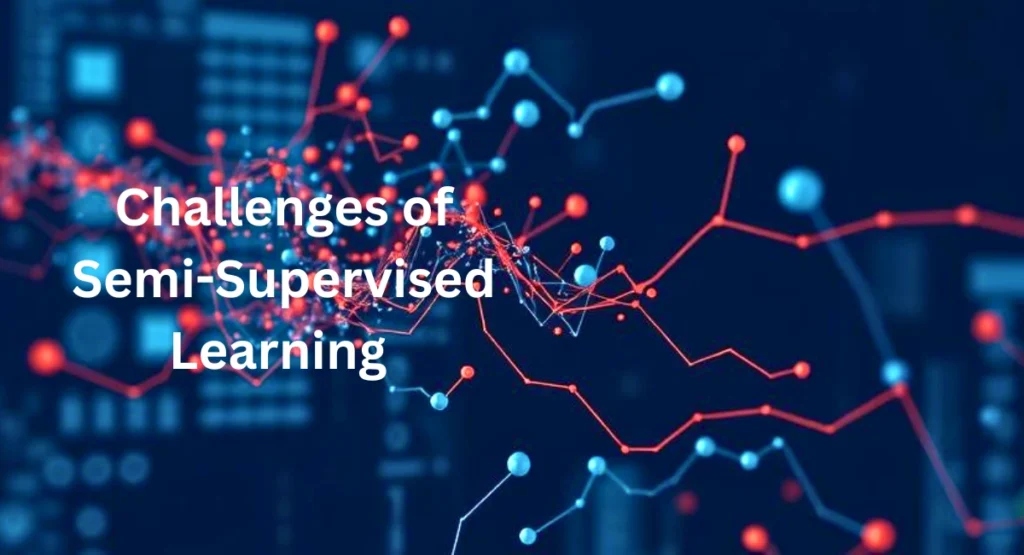
With the benefits, several challenges also surfaced on top. To implement semi-supervised learning efficiently, you need to address the following challenges:
- Reliance on high-quality labeled data: The most common issue is the quality of data. If the model learns from unbiased, noisy, unlabeled examples, it can lead to several compounding errors.
- Risk of Overfitting: There is also an overfitting risk when the limited labeled data is not generalized or regularized properly.
- Data Distribution Shifts: If the unlabeled data distribution separates from the labeled dataset, model performance can be compromised.
- Complex model tuning: Similarly, balancing the assistance of labeled and unlabeled data needs careful hyperparameter tuning and model design.
Popular Tools and Libraries for Semi-Supervised Learning
In case you want to learn and practice a semi-supervised algorithm and model and don’t know where to start, here are some popular tools and libraries you can use for SSL.
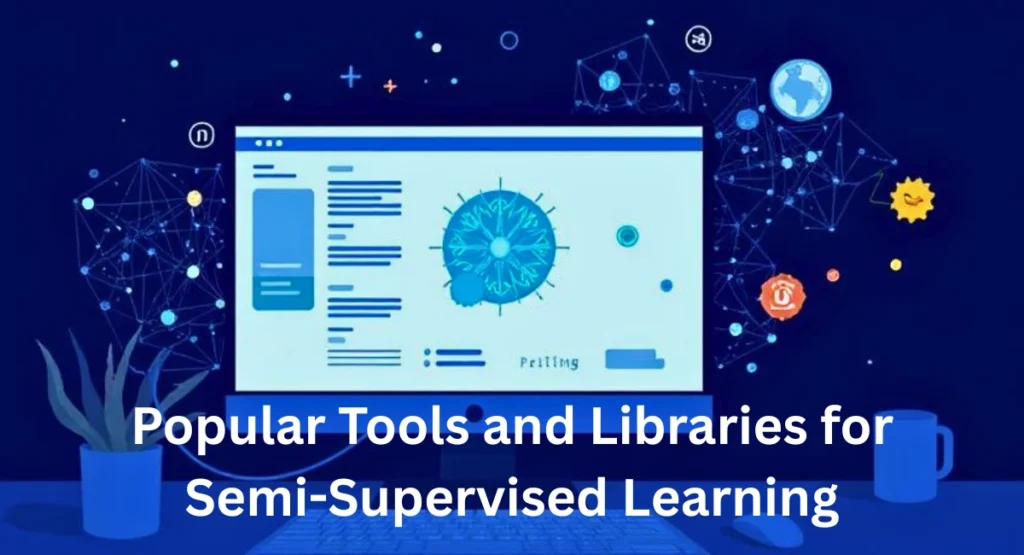
Scikit-learn
Scikit-learn is one of the common libraries that offer basic support for semi-supervised learning through models like LabelPropagation and LabelSpreading. These graph-based algorithms correlate labelled and unlabeled data points for label propagation effectively. It is best for prototyping SSL tasks in Python, particularly for small datasets.
PyTorch Lightening
PyTorch Lightning is an advanced wrapper for PyTorch, easing the training loop for custom SSL models. Researchers or developers can instantly test custom architectures with pseudo-labeling, consistent regularisation, or MixMatch-type strategies. It is best suited for advanced users developing scalable, research-grade SSL systems.
TensorFlow and Keras
These tools offer advanced support for semi-supervised learning through custom training loops, built-in APIs, and community-built tutorials. Developers can integrate techniques like pseudo-labeling and self-training easily with its flexible, functional API and model subclassing.
Open-source SSL Repostriores
Several open-source GitHub repositories and benchmarks, such as Fixmatch, MixMatch, and UDA, are available that offer pre-built implementations of state-of-the-art semi-supervised learning algorithms. This will help researchers for fast-track development and experimentation in academic and industrial settings.
The Future of Semi-Supervised Learning
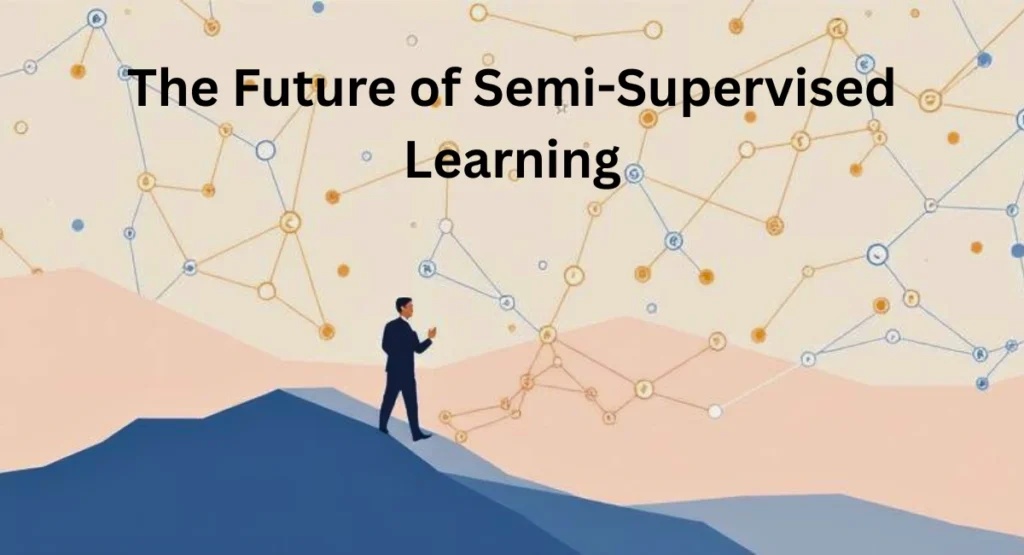
Many advancements and techniques are being applied in semi-supervised learning as it is the best, cost-effective approach in many use cases. It is integrated with self-supervised learning approaches, where models learn classification from unlabeled data through pretext tasks. This blending can result in improved generalization, particularly when the data is insufficient.
Moreover, privacy-focused machine learning is growing rapidly, which means semi-supervised learning can be used in edge and federated settings. It is greatly effective in mobile, healthcare, and IoT applications as it allows the model to learn locally from unlabeled data without sending user-sensitive information. Currently, the latest trends and research are revolving around multimodal semi-supervised learning across text, images, and audio data.
Conclusion
In conclusion, semi-supervised learning is a machine learning technique that acts as a hybrid approach between supervised and unsupervised learning. It works by combining the strengths of both machine learning models, such as labeled data from supervised and unlabeled data from unsupervised, to build a highly effective and scalable model with minimal supervision.
This particular type of learning is useful in many areas, such as sentiment analysis, determining suspicious activities in transactions, or image detection. In short, this learning is highly useful when you have to work on a large dataset with limited resources. In this guide, our Vista Vibrante expert team makes a little effort to help you understand what semi-supervised machine learning is!
FAQs
What is the difference between unsupervised and semi-supervised learning?
- In a nutshell, unsupervised learning techniques use unstructured data. Semi-supervised learning techniques mix both labeled and unlabeled training data to improve model performance. Unlike unsupervised learning, the other learning is used when a few labeled samples are available.
What are the 4 types of machine learning methods?
- It includes supervised learning, unsupervised learning, semi-supervised learning, and reinforcement learning.
Is CNN semi-supervised?
- Well, CNNs are not completely semi-supervised, but they can be used in a semi-supervised setting in combination with SSL techniques.



